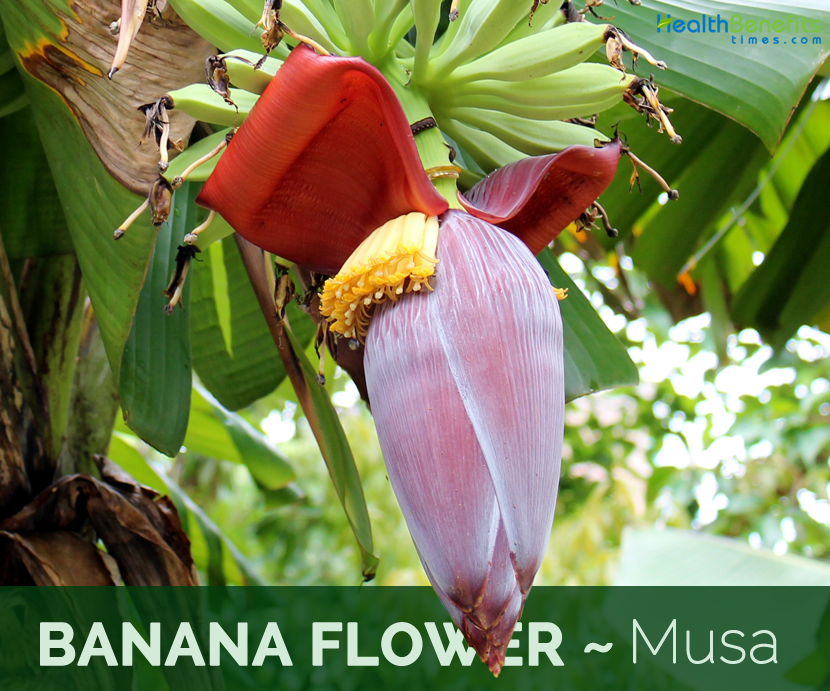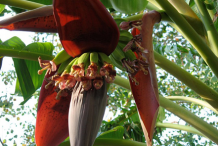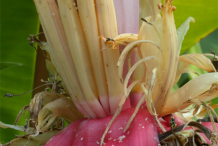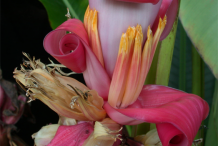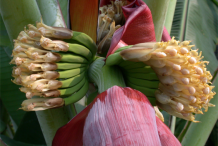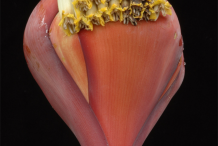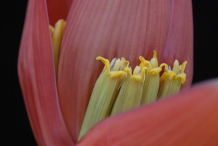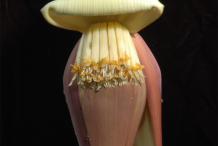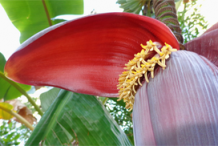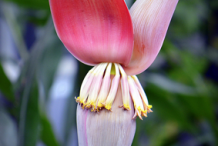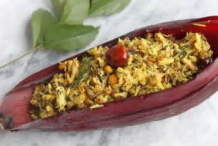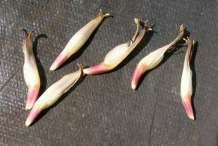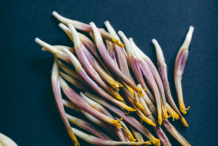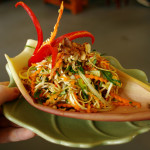History
The South East Asians were the first peoples known to cultivate banana plants. In Malaysia the prepared blossoms as well as immature green fruits are combined and cooked into a curry. The Indonesians slice the fruit and simmer it in coconut milk then serve it as a vegetable. Nowadays Many Asian cultures eat banana blossoms. Blossoms are available fresh (preferred) or canned in Asian grocery stores.
Health Benefits of Banana Flower
The banana flower serves the health benefits which are as follows:
1. Curing the infection
The banana flower has ability to treat infection because it possesses ethanol flowers which helps to prevent the pathogenic bacterial growth. It can cure the wound as well. The extracts of banana flower helps to prevent the growth of malaria parasites.
2. Overcoming diabetes and anemia
The diabetic patients should consume banana flowers either boiled or alone so that it reduces the level of blood sugar and raise the hemoglobin in the body as it is rich in fiber and iron which assists in red blood cell production. The pan should be heated with the oil and put mustard seeds till it crackles, then ½ tsp. of urad dal and channa dal should be added frying till it is brown and then 1/8 cup of cut shallots and curry leaves should be added. The banana flowers which are cut should be added with a tsp. of sambar powder, ¼ tsp. of turmeric powder and salt. Then it should be cooked by covering. Then it should be fried in a low flame so that the water evaporates fully then a tbsp. of fresh coconut scrapings should be added and switch off. It works a great for diabetic patients.
3. Improves lactation
The breast milk supply is increased for the lactating mothers. It helps to cure the excessive bleeding, maintains healthy uterus, restrict constipation during pregnancy and promotes lactation. It should be combined with other spices to make the good taste. The fresh one should be selected. The recipe for Indian pancakes or adai or dosai is firstly, 1 cup of rice should be soaked with 1 tbsp. moong dhal, 2 tbsp. urad dhal, 1 tbsp. channa dhal and ¼ cup toor dhal for overnight. The next day, 2 red chillies should be grind with little Coconut, small piece of Asafoetida, a tsp. of Cumin seeds which should be added to the dal grind after soaking overnight, with required salt. The cleaned banana flower which is cut should be fried in a little oil and then add to the batter in order to make dosais. This is high in fiber which helps to eliminate pregnancy constipation.
4. Reduce Free Radical Activity
The free radicals lead to various problems. The antioxidant property is possessed in the banana flower. It also treats the health problems like cancer and premature aging. It should be included in health supplements in order to make the full use of antioxidant properties.
5. Menstrual problems and weight loss
It increases progesterone which helps to reduce the excessive bleeding. ¼ cup of banana flower should be cooked in a little water and salt till it is completely cooked. After it is cooled, in ¼ cup coconut, 2 g. chilies, ½ tsp. cumin seeds should be added to make a thick and fine taste. The coconut mixture should be added to the thick yogurt with the cooked banana flowers and required salt. Excess bleeding could be treated if this is eaten with rice. As it is rich in fiber and nutrients, it results in weight loss. It soothes the stomach as well. For weight loss, the banana flowers should be added to the salads and soups.
6. Rich source of Vitamin and minerals
The banana flowers possess the Vitamin C, A, E, fiber and potassium which are the sources of healthy nutrient.
7. Boost Mood and Reduce Anxiety
It improves the mood and lessens anxiety due to the magnesium present in banana flowers. They serve as anti-depressants without side effects.
8. Anti-ageing power
It helps to encounter the free radicals and cure the health issues related to it such as cancer and early aging.
9. Healthy uterus
It helps to prevent from the uterus problems. To boost the healthy uterus, the banana flowers should be added with turmeric powder, peppercorns and cumin seeds. The banana flowers should be boiled with minor peppercorns and cumin seeds; ¼ tsp. of turmeric powder and salt till it is half. The uterus problems are eliminated by drinking this decoction.
10. Gastrointestinal health
Banana flowers are rich in soluble and insoluble fiber. A soluble fiber allows the food to pass easily through the digestive tract as it dissolves in water and forms a gel. Insoluble fiber assist the bulk to undigested products as it is not dissolved in water. Both of it boost the healthy digestion and absorption of food.
11. Cancer and Heart disease
Banana flowers are high source of tannins, acids, flavonoids and other antioxidants which helps to counteract free radicals and eliminates the oxidative damage which leads to cancer and heart disease. The banana flower can prevent these conditions.
12. Neural disorders
The free radicals may cause Alzheimer and Parkinson’s disease which may be prevented by consuming banana flowers regularly.
https://www.youtube.com/watch?v=Jkqlb_4GiK4
How to select
The firm and fresh flower should be purchased. It should be free from the cuts and blemishes, smooth appearance and bright. The overlapping of outer leaves should be tight.
How to store
Fresh one should be used. It should be wrapped in transparent plastic, cover in zip lock bags and store it in a refrigerator.
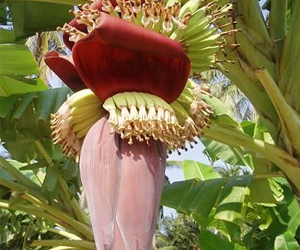
Traditional uses and benefits of banana flower
- Flower is used as a traditional medicine to treat bronchitis, constipation, menstrual cramps and ulcer problems.
- It boosts mood and reduces the anxiety because the banana flowers are having high levels of magnesium.
- It regulates the blood pressure.
- Consuming of cooked banana flower with curd is most efficient way to treat the excessive bleeding during menstruation.
- It reduces the bleeding associated with menorrhagia.
- It lowers the blood cholesterol, and promotes the functional efficiency of kidneys.
How to Cut and Clean Banana Flower
To fully benefit from the health-promoting properties of banana flower, it is important that you know how to cut and clean it properly. Only then can this food be of real help to you! Therefore, have a look at the related aspects.
- First, smear some mustard oil on the palms to prevent them from getting discolored while you peel you the flower.
- Slowly take out each bract and gather the tiny florets.
- Continue doing so till you touch the innermost portion where, you will notice a bulb of yellow shade.
- Now take each floret and remove its transparent covering as well as the tiny-sized head.
- Then cut all the florets into small pieces.
- Move the floret pieces into a container having water.
- Put 1 tbsp of yogurt and ½ tsp salt in the container. This will minimize the extent to which the banana flower gets oxidized.
- You can now cook the banana flower.
Culinary uses
-
- It can be simply chopped and used in salads.
- It can also be added to spinach salads.
- Banana flowers can be used in soups or sliced and added to stir-fries.
- In Thailand banana flower is almost always served raw on the side with pad thai.
- In Indonesian cuisine, banana flowers are mixed with pork and a hot sambal, cooked in a section of bamboo and served at their festivals or wakes.
- It is also served simmered in soup or fried with thin noodles.
- Other Asian and Indian cuisines add the sliced banana flower to meat stews, stir-fries, soups, and rice or noodle combinations.
- It is also used in cold salads, with the salad mixture presented to the diner in one of the large purple-red outer bracts.
- In the Philippines banana flowers are the main ingredient in linabog or labog, a dish made with coconut milk, spices and dried fish.
Recipe
Banana Blossom Salad
Ingredients:
- 2 banana blossoms
- 1 tablespoon of butter
- 1 spring onion cut fine
- 500 grams shelled and cooked prawns
- 5 tablespoons of roasted almonds or assorted nuts
- 1 teaspoon sour lime juice or even lemon
- Salt and pepper
Method:
- Core and cube the banana flowers as well as immerse them overnight within a bowl of water that consists of a tablespoon of vinegar. Clean and trench well.
- Cook the prawns within the butter together with a pinch of pepper and salt.
- Grind the nuts indelicately so that it forms a lumpy mix not an even paste.
- Include all the components into a bowl and toss for a minute or even two.
- Chill for 30 minutes and after that garnish along with a mint sprig and serve.
Banana Flower Facts
The banana flower is also known as a banana blossom or a banana heart and it is a drop-shaped purple flower that hangs at the end of a cluster of bananas. Considered an Asian or tropical vegetable, it has a deep crimson color and consists of tightly packed leaves or bracts that wrap around rows of thin stemmed male flowers. It is the inner pale colored bracts that are used for food dishes. Banana flowers can be sliced and served in meat stews, soups, rice or noodle dishes, and cooked vegetable dishes.
| Banana Flower Quick Facts | |
|---|---|
| Name: | Banana Flower |
| Scientific Name: | Musa Spp. |
| Origin | Southeast Asia - Indo Burma region is considered as the center of origin of banana. |
| Colors | Color of main bud is red-orange to deep purple. Flowers are white or cream color |
| Shapes | Teardrop shaped purple flower at the end of the banana cluster. Flowers are slim, Torpedo-shaped. They’re bunched in circled double rows along the bloom, with each cluster covered by a thick, waxy petal. |
| Taste | Raw taste starchy and bitter. Cooked flower taste like artichoke leaves |
| Calories | 51 Kcal./cup |
| Major nutrients | Manganese (2117.39%) Copper (1444.44%) Iron (705.00%) Total dietary Fiber (15.00%) Potassium (11.77%) |
| Health benefits | Curing the infection Overcoming diabetes and anemia Improves lactation, Reduce Free Radical Activity, Menstrual problems and weight loss Boost Mood and Reduce Anxiety Anti-ageing power Gastrointestinal health |
| Name | Banana Flower |
|---|---|
| Scientific Name | Musa Spp. |
| Native | Southeast Asia – Indo Burma region is considered as the center of origin of banana. |
| Common Names | Banana blossom or a banana heart |
| Name in Other Languages | Arabic: Maouz, Maozeh (Lebanese), Mauz, Mazw, Moaz, Mouz, موز Moz (Egypt). Armenian: ադամաթուզ Adamat’uz, բանան. Assamese: Kala(কলা ) Bengali: Kala (কলা ) Burmese: (nghak-pyau:) Hnget pyaw / Nget pyaw, Nget pyo thee, Nga pyaw thee, Nga pyaw phoo (flower). Catalan: Banana (fruit), Bananer, Plàtan (fruit). Chinese: Jiao (Tsiu, Chiu), Shang chao fua ( flower). Czech: Banánovník. Danish: Banan, Bananer, Bananbusk (plant), Banantræ (plant). Dutch: Banaan, Bananen, Banaanboom (plant), Banaanplant, Bananeplant. English: Banana, Banana tree, Banana shrub. Finnish: Banaanit, Banaanirata, Banaanikasvi (plant). French: Banane, Bananes, Bananier (plant), Figue (ingredient, dried fruit – Caribbean-Sea islands). German: Banane, Bananen, Bananenpisang, Bananenstaude (plant). Greek: Banána (Μπανάνα). Gujrati: Kēḷāṁ (કેળાં), Kēḷuṁ (કેળું) Hausa: Ayaba. Hebrew: Bnnwţ (בננות) ,Vananah Bȧná̇náh (בַּנָּנָה) Hindi: Kadali (कदली ), Kela (fruit) (केले ), Kela kaa per (plant) (केले का पेड़ ), Kelaa (fruit) (केला ), Kelaa kaa phuul (Kelaa ka fool / Kere kafool) (flower) (केला का फूल ), Paapraa (पापड़ा) Icelandic: Banani Italian: Banana, Banane, Banano (plant). Japanese: Banana (バナナ), Banana no ki (plant) (バナナの 木), Banana no tsubomi (flower), Bashou (バショウ). Kannada: Kadali (ಕದಳಿ ), Baale (balay) (ಬಾಳೆ ), Baalehannu (Balayhanu) (ಬಾಳೇಹಣ್ಣು), Bāḷehaṇṇu (ಬಾಳೆಹಣ್ಣು), bale kaayi(ಬಳೆ ಕಾಯಿ). Khmer: Cheek nam’vaa, Chec. Korean: Banana (바나나) Panana. vaazha Laotian: Makkuany (ໝາກກ້ວຍ), Mak guy, Kwàyz, Kok khone. Malagasy: Akondro Malay: Pisang, Getang (Indonesia), Jantung pisang (flower), Djantoong (Indonesia). Malayalam: Ma’ūcaṁ( മഊചം), Maoocham (Maaucam), vāḻa (വാഴ) Vaazha, vāḻappaḻaṁ (വാഴപ്പഴം) Vaazhappazham. Marathi: Vēlacī (वेलची) Velachi Nepalese: Bungo (बुङ्गो) Polish: Drzewo bananowe, Bananowca, Bananowiec. Portuguese: Banana, Bananas, Bananeira (plant). Russian: Banan (банан) Serbian: Banana (бана́на) Sinhalese: Kehel, Kehel mal. Slovakian: Bananovec. Slovanian: Banánovník. Spanish: Banana, Platano, Plátanos, Cambur (plant), Banano (plant), Platanero (plant). Swahili: Ndizi, Maso. Swedish: Bananer. Tagalog: Saging (Fruit), Puso (flower), Punong saging (plant). Tamil: Valai tantu (வாழை தண்டு (stem)), வாழை Vaazhai, வாழைபூ Vaazhaipoo (flower), வாழை மரம் (plant), வாழைப்பழம், Vazhei. Telegu: Arati (అరటి), Artipandu(అరటిపండు), Kadala(కదళ ) Thai: กล้วย Kluai / Kluay / Klue / Kluey / Gluai / Glooway / Gkloo ay, Dok kluai (flower), Hua blee (flower). Turkish: Muz. Urdu: کيلا Kelaa (Keyla), كيلا كا پهول Kelaa kaa phuul (flower), کيلا Kelaa, موز Mauz. Vietnamese: Hoa chuối (flower), Bắp chuối (flower), Cây chuối (leaf), Quả chuối (fruit). Yoruba: Ọ̀gẹ̀dẹ̀, Ogede. |
| Fruit Shape & Size | Teardrop shaped purple flower at the end of the banana cluster. Flowers are slim, Torpedo-shaped. They’re bunched in circled double rows along the bloom, with each cluster covered by a thick, waxy petal. |
| Fruit Color | Color of main bud is red-orange to deep purple. Flowers are white or cream color |
| Flavor/Aroma | Nutty flavor |
| Taste | Raw taste starchy and bitter. Cooked flower taste like artichoke leaves |
| Major Nutrition | Manganese, Mn 48.7 mg (2117.39%) Copper, Cu 13 mg (1444.44%) Iron, Fe 56.4 mg (705.00%) Total dietary Fiber 5.7 g (15.00%) Potassium, K 553.3 mg (11.77%) Phosphorus, P 73.3 mg (10.47%) Carbohydrate 9.9 g (7.62%) Vitamin E (alpha-tocopherol) 1.07 mg (7.13%) Calcium, Ca 56 mg (5.60%) Protein 1.6 g (3.20%) Total Fat (lipid) 0.6 g (1.71%) |
| Calories in (100 gm) | 51 K cal |
| Health Benefits |
|
References:
http://www.plantnames.unimelb.edu.au/Sorting/Musa.html
https://npgsweb.ars-grin.gov/gringlobal/taxonomydetail.aspx?id=312415
https://plants.usda.gov/java/ClassificationServlet?source=display&classid=MUSA2


